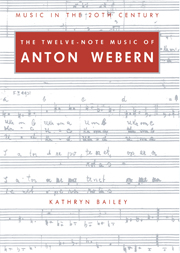Book contents
Introduction to Part I
Published online by Cambridge University Press: 23 December 2009
Summary
The stages in Webern's composition of all but one of the twelve–note works can be followed in a series of six sketchbooks. The first of these, which was begun in June 1925, includes sketches of the posthumously published Klavierstück and Kinderstück, the six songs of Opp. 17 and 18 and the first of Op. 19; this is owned by the Pierpont Morgan Library in New York City. The next book, begun in January 1926, contains the conclusion of Op. 19; this and four subsequent books, all owned by the Paul Sacher Stiftung in Basel, cover the remaining works except for the two published movements of Op. 20, sketches for which apparently do not exist. A fair copy of Op. 20, owned by a private collector in Basel and unavailable for inspection, has been described by Moldenhauer as ‘an ink score of the two finished movements, in which Webern still made many alterations’.
The sketches for each work begin with a statement of the row. In the songs Opp. 17–19 and in several of the works after Op. 20 – Opp. 22, 24, 26, 29 and 31 – preliminary work records the evolution of this row through a series of experiments and variations. Sketches of Opp. 21, 27 and 30 begin with a row slightly different from the one finally used; one or two alterations lead to the definitive version. In Opp. 22, 24, 26 and 29 the final version is marked gilt (valid, okay); in the remaining instances, the experimentation simply ceases when a satisfactory row has been achieved.
- Type
- Chapter
- Information
- The Twelve-Note Music of Anton WebernOld Forms in a New Language, pp. 9 - 12Publisher: Cambridge University PressPrint publication year: 1991



